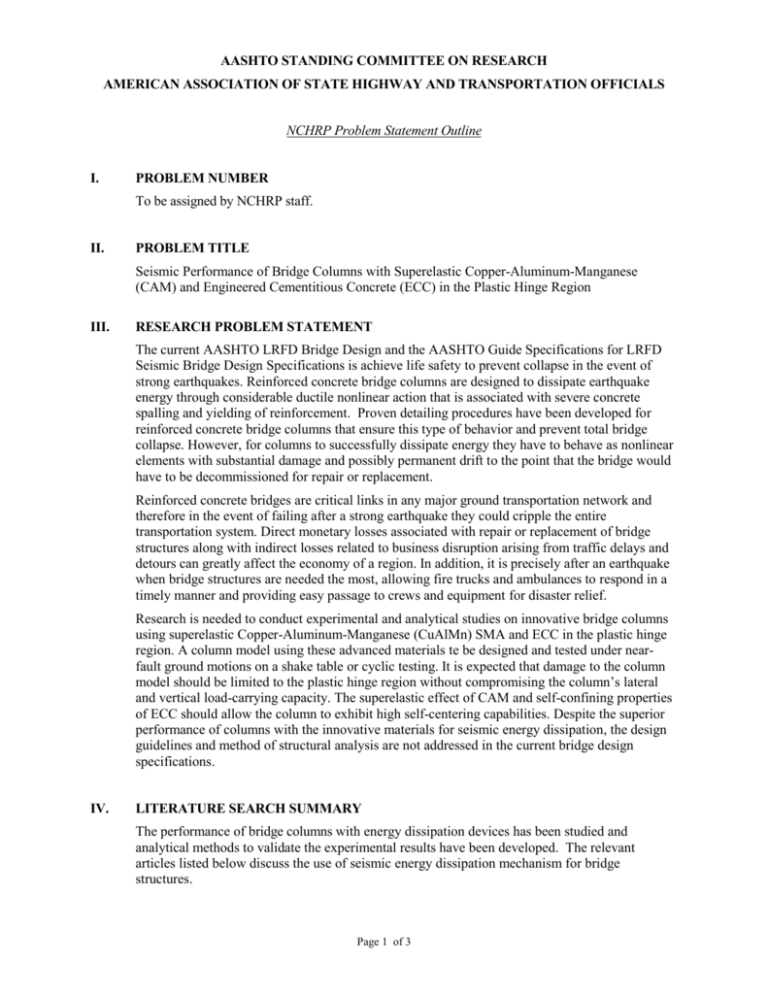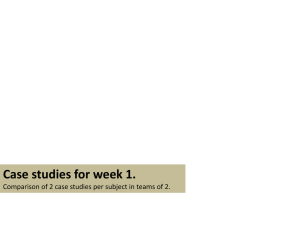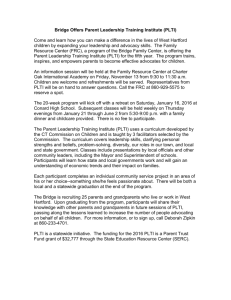ATTACHMENT TO BTS LETTER
advertisement

AASHTO STANDING COMMITTEE ON RESEARCH AMERICAN ASSOCIATION OF STATE HIGHWAY AND TRANSPORTATION OFFICIALS NCHRP Problem Statement Outline I. PROBLEM NUMBER To be assigned by NCHRP staff. II. PROBLEM TITLE Seismic Performance of Bridge Columns with Superelastic Copper-Aluminum-Manganese (CAM) and Engineered Cementitious Concrete (ECC) in the Plastic Hinge Region III. RESEARCH PROBLEM STATEMENT The current AASHTO LRFD Bridge Design and the AASHTO Guide Specifications for LRFD Seismic Bridge Design Specifications is achieve life safety to prevent collapse in the event of strong earthquakes. Reinforced concrete bridge columns are designed to dissipate earthquake energy through considerable ductile nonlinear action that is associated with severe concrete spalling and yielding of reinforcement. Proven detailing procedures have been developed for reinforced concrete bridge columns that ensure this type of behavior and prevent total bridge collapse. However, for columns to successfully dissipate energy they have to behave as nonlinear elements with substantial damage and possibly permanent drift to the point that the bridge would have to be decommissioned for repair or replacement. Reinforced concrete bridges are critical links in any major ground transportation network and therefore in the event of failing after a strong earthquake they could cripple the entire transportation system. Direct monetary losses associated with repair or replacement of bridge structures along with indirect losses related to business disruption arising from traffic delays and detours can greatly affect the economy of a region. In addition, it is precisely after an earthquake when bridge structures are needed the most, allowing fire trucks and ambulances to respond in a timely manner and providing easy passage to crews and equipment for disaster relief. Research is needed to conduct experimental and analytical studies on innovative bridge columns using superelastic Copper-Aluminum-Manganese (CuAlMn) SMA and ECC in the plastic hinge region. A column model using these advanced materials te be designed and tested under nearfault ground motions on a shake table or cyclic testing. It is expected that damage to the column model should be limited to the plastic hinge region without compromising the column’s lateral and vertical load-carrying capacity. The superelastic effect of CAM and self-confining properties of ECC should allow the column to exhibit high self-centering capabilities. Despite the superior performance of columns with the innovative materials for seismic energy dissipation, the design guidelines and method of structural analysis are not addressed in the current bridge design specifications. IV. LITERATURE SEARCH SUMMARY The performance of bridge columns with energy dissipation devices has been studied and analytical methods to validate the experimental results have been developed. The relevant articles listed below discuss the use of seismic energy dissipation mechanism for bridge structures. Page 1 of 3 1. Varela, S., and Saiidi, M., “Dynamic Performance of Innovative Bridge Columns with Superelastic CuAlMn Shape Memory Alloy and ECC,” International Journal of Bridge Engineering Vol. 2, No. 3, 2014, pp. 29-58. 2. Saiidi, M., M. O’Brien, and M. Zadeh, “Cyclic Response of Concrete Bridge Columns Using Superelastic Nitinol and Bendable Concrete,” American Concrete Institute, ACI Structural Journal, Vol. 106, No. 1, January-February 2009, pp. 69-77. 3. Saiidi, M., and H. Wang, “An Exploratory Study of Seismic Response of Concrete Columns with Shape Memory Alloys Reinforcement,” American Concrete Institute, ACI Structural Journal, Vol. 103, No. 3, May-June 2006, pp. 436-443. 4. Saiidi, M., M. Zadeh, C. Ayoub, and A. Itani, “A Pilot Study of Behavior of Concrete Beams Reinforced with Shape Memory Alloys,” Journal of Materials in Civil Engineering, ASCE, Vol. 19, No. 6, June 2007, pp. 454-461. 5. Saiidi, M. and M. Zadeh, “Seismic Response of SMA-Reinforced ECC Columns,” http://wolfweb.unr.edu/homepage/saiidi/NCHRP/Seismic/FRPhome.html. 6. Saiidi, M. and D. Sanders, “Precast Bridge Columns with Energy Dissipating Joints,” http://cceer.unr.edu/caltrans/precast.html. V. RESEARCH OBJECTIVE The objective of this research is to develop stand-alone recommended Specifications and method of structural analysis for bridge structures with Energy Dissipation Mechanism in their columns. In developing these specifications, consideration shall be given to constructability, safety, maintenance and inspection issues. Develop a detailed research plan for accomplishing the project objective. Proposals must present the proposers' current thinking in sufficient detail to demonstrate their understanding of the issues and the soundness of their approach to meeting the research objective. This proposed research include the following Tasks Task 1. Review of existing specifications, technical literature, and pertinent publications and reports. Task 2. Identification of knowledge gaps including (a) new and modified design approach and (b) load combinations and resistance factors, and a proposed approach to fill these gaps in the final product. Task 3. Analytical study of bridge columns novel bridge columns with superelastic CopperAluminum-Manganese (CAM) and Engineered Cementitious Concrete (ECC) in the plastic hinge region Task 4. Experimental program based on the results of the analytical testing bridge columns with superelastic Copper-Aluminum-Manganese (CAM) and Engineered Cementitious Concrete (ECC) in the plastic hinge region Task 5. Identification of any items from the AASHTO LRFD Bridge Design Specifications, and other AASHTO publications that are duplicated in the newly recommend specifications. Task 6. Design examples using the proposed specifications and method of analysis. Task 7. A final report that documents the entire research effort. VI. ESTIMATE OF PROBLEM FUNDING AND RESEARCH PERIOD Recommended Funding: $450,000 Research Period: 36 Months Page 2 of 3 VII. PERSON DEVELOPING THE PROBLEM Bijan Khaleghi, PhD, P.E., S.E. State Bridge Design Engineer Washington State DOT Bridge and Structures Office Tumwater, WA 98501 Phone: 360 705-7181 khalegb@wsdot.wa.gov VIII. PROBLEM MONITOR To be assigned by AASHTO to monitor the research, if programmed, from inception to completion. The monitor's final responsibility will entail recommendations to the Standing Committee on Research as to how the research results could be implemented. IX. DATE AND SUBMITTED BY October 9, 2015 Tom Baker, P.E. (Primary Member) State Bridge and Structures Engineer Washington State Department of Transportation P.O. Box 47340 Olympia, WA 98504-7300 Phone: (360) 705-7207 E-mail: BakerT@wsdot.wa.gov Page 3 of 3






